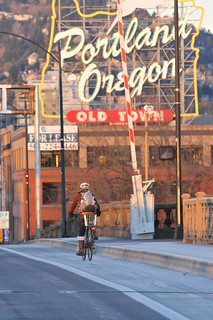Multnomah County alone has created more new “professional and technical service” jobs in the last three years than the Columbia River Crossing was projected to create throughout the region, in all sectors combined, by 2030.
It’s a fact that was underscored Friday by Mayor Charlie Hales’ announcement that San Francisco-based startup Airbnb will move 160 employees and its North American operational headquarters to Portland’s Old Town area.
That was the latest sign that Portland’s tech sector is in the middle of an historic boom — and a stark contrast with the freeway-rail project, once called essential to the region’s economy, that seems to have been killed by the state legislature one week ago.
According to the Columbia River Crossing project team’s own calculations, the long-term economic impact of increasing the capacity of Interstate 5 would be to create 3,441 more jobs around the region by 2030. That’d be about 0.15 percent of the region’s future workforce.
But even as the consensus around the CRC project collapsed (leaving behind, of course, hundreds of millions of dollars for other local priorities) Portland’s central city became a new hub for white-collar service employees at tech companies like New Relic, Walmart Labs, Urban Airship and eBay.
It’s added 4,000 new jobs in the professional and technical services industry since 2011, according to state estimates.

“Computer programming jobs are up 15 percent in the last few months — that’s fantastic,” state economist Christian Kaylor said in a December interview. “Multnomah County is creating in the last three years, on average, 20,000 jobs a year.”
The county’s key advantage in this job growth, Kaylor said, is its huge supply of skilled labor, driven by an apparently overwhelming desire of college graduates to live in Portland.
“People with college degrees are disproportionately moving to the City of Portland and almost actively avoiding Washington County, Clackamas County, Clark County,” Kaylor said. “Which is also new.”

that employers are increasingly trying to locate in places
employees find desirable.
It’s not as if good walking, biking and transit options are the only factors, Kaylor said. But he thinks they’re “huge” in the city’s appeal.
Kaylor said he’s actually worried about the economic future of Clackamas County, which of all the region’s counties seems to be struggling most to attract young residents.
“The City of Portland is growng five times faster than Clackamas County — that’s just nuts,” he said. “If you look at just the population 18-64, Clackamas County is shrinking. … To have so much job growth centered in an urban area in a region — this is something we haven’t seen since the 1940s with the Liberty Shipyards.”
This is a trend we’ve seen here at BikePortland in our coverage of the commercial real estate scene, which has been investing more and more in bike-friendly facilities, locating close to homes that appeal to bike-friendly workers and choosing office buildings that are close to active urban places like food cart pods.
“To stay relevant as an employer, you have to create places where people really want to be,” developer Leonard Barrett said last fall.


